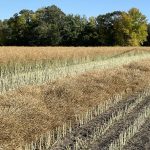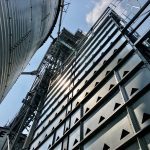Feed that might be high in nitrates must be tested to determine its concentration so it can be blended or diluted and safely fed to cattle.
When blending low nitrate feed with problem feed, the amount required to dilute the problem feed will depend on the level of nitrates in the forage (See Table 1).
Animals will need to adapt slowly to feed containing nitrates, a process that takes one to two weeks.
Cattle that go off high nitrate feeds for a few days will need to be readapted to the problem feed if it is to be fed again. Adaptation periods can be shortened by feeding limited amounts of the ration frequently throughout the day instead of one large feeding once a day.
Read Also

VIDEO: Green Lightning and Nytro Ag win sustainability innovation award
Nytro Ag Corp and Green Lightning recieved an innovation award at Ag in Motion 2025 for the Green Lightning Nitrogen Machine, which converts atmospheric nitrogen into a plant-usable form.
The low and high nitrate feeds need to be blended to decrease toxicity. This does not mean putting out one low-nitrate and one high-nitrate bale free choice because the animals may eat only the high nitrate feed, which would be toxic.
Feeding supplemental grain, such as two to five pounds per head per day, with high nitrate forages can assist with the dilution of the nitrate level. The energy provided by the grain also helps rumen microorganisms convert nitrite into ammonia, which can than be excreted via the urine and feces.
Balancing rations is important when using high nitrate feed because the nitrate level can increase the animal’s requirements of vitamin A. If the ration requires supplemental protein, avoid using non-protein nitrogen such as urea because this can make the situation worse.
Avoid feeding high nitrate feed to sick, hungry, pregnant or lactating animals. These animals have a lower tolerance level to the nitrate compared to healthy cattle. Make sure all animals have access to plenty of clean drinking water because this will help dilute the nitrate in their bodies.
A feed test is necessary to effectively dilute high nitrate feed. Once a producer knows how much is in the feed, he can dilute it to the safe level of 0.5 percent nitrate.
Different labs express the nitrate levels in various ways. Table 2 provides a conversion system to help determine the level of nitrates in forage.
Prussic acid is also known as hydrogen cyanide and levels exceeding 500 parts per million on a dry matter basis can be dangerous for livestock. To avoid problems do not allow hungry cattle to graze crops with prussic acid problems.
Ensiling forages that have high levels of hydrogen cyanide can reduce the toxic compound as well as nitrate by as much as 50 percent.
However, if the levels were extremely high to begin with, this reduction may not be enough to avoid problems. Test all suspect feeds.
Provincial or private feed labs, along with provincial livestock specialists, can assist in developing feed rations to deal with high nitrate level feeds.














